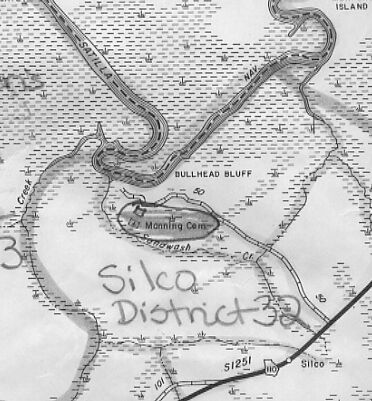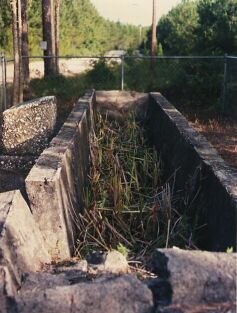 |
| Bullhead Bluff (unincorporated county).
Map of Bullhead Bluff in Silco District Located off of Hwy. 110 near the Charlton County border, Bullhead Bluff is nestled against the south side of the Satilla River. In an area commonly referred to as Silco, Bullhead Bluff is a small community of families, many of whom have lived here for generations. Camden's Challenge mentions that a Georgia Militia detachment under the command of Lt. John Gray was stationed out at Bullhead Bluff during the 1790's as defense against Indian raids. (CC p25) There were numerous timber mills located nearby – including Owen's Ferry and Burnt Fort. In fact, the railroad owned and operated by the Suwannee Canal Company went from the Okefenokee Swamp in Charlton County to Bullhead Bluff. (CC p64) Bullhead Bluff Plantation was originally owned by Joseph
Thomas, Sr. He
deeded the property to his son, Joseph, Jr. in 1829. I'm not sure what
happened to these Josephs, but my guess is that they are related to
Eliza Thomas, who married D. Britton Manning; that would certainly explain how the
Mannings got a foothold in Bullhead. (CC p36) Photo to right of Montfort Island, Near Bullhead Bluff, on the Satilla River. The Manning Family Since the mid-1800's the Manning family has owned much of the land out there. Over the years the original plantation has been subdivided into smaller and smaller pieces. Many families of Mannings still call Bullhead Bluff home. In addition, the Manning family cemetery is still in use and is one of the few well-maintained private cemeteries in the county. The earliest Manning I have a record for is Damon Britton Manning (5/30/1860-1/24/1936), the husband of Eliza Thomas (8/18/1864-9/4/1949), they are both buried in Brazell Cemetery, south of Kingsland. Was Eliza Thomas a daughter of Joseph Thomas, Jr.? Damon Britton, Sr. and Eliza were the parents of:
(These are not necessarily in order.) Freedmen's Cemetery There's another old cemetery at Bullhead that has a very interesting story behind it. Robert Stafford was a wealthy plantation owner on Cumberland Island. After the Civil War his slaves, of course, had to be freed. Some of them ended up settling around Bullhead Bluff. The cemetery goes by many names including "Stafford, Gibbs, and Silco." It's right off of Bullhead Bluff Road (on the north side) but as it's in the woods it isn't noticeable from the road. It's in terrible shape. Several times the river has flooded the cemetery and caused the coffins to rise out of the ground. County workers put them back but of course the damage to the stones is great. Most graves aren't legible anymore. Many of these freedmen took on the surname of Stafford. While I could not find any marked Stafford graves when I visited the cemetery in 1998 or 1999, Mary Bullard, in her book, "Robert Stafford of Cumberland Island" writes that she found many Stafford graves when she visited in 1988. She writes: "A Freedmen's Cemetery
I have heard the area referred to as "Plum Orchard." As there was a Plum Orchard on Cumberland this would support the theory that freed Cumberland slaves settled at Bullhead.
In the first half of the 20th century, the federal and state governments worked together (can you believe it?) to eradicate the ticks which cause "cattle fever." To that end, thousands of "tick or cow dipping vats" were constructed. The only one left in Camden County is at Bullhead Bluff. From the USDA APHIS website: "Begun in 1907, the Cattle Fever Tick Eradication Program (CFTEP) was the first cooperative state-federal eradication effort. In 1943, the two species of Cattle Fever Ticks (CFTs), Boophilus annulatus and B. microplus, were eradicated from the U.S., with the exception of a permanent quarantine zone between Texas and Mexico. Today, this "buffer" zone extends over 500 miles from Del Rio, TX to the Gulf of Mexico and is 200 yards to 6 miles wide. Outbreaks outside of the zone are rare. Premises found to be infested with CFTs are placed under quarantine for six to nine months, depending on the time of year." Generally, the vats were constructed of concrete. The cattle were walked through the vat, which was filled with arsenic. Today, arsenic is no longer used on cattle and the tick which causes cattle fever has been eradicated. Unfortunately, it is still prevalent in Mexico where it regularly crosses the border. However, due to constant monitoring, the ticks have so far not regained any of their territory. Unfortunately, it looks like they may be growing resistant to current pesticides. From Tektran's (United States Department of Agriculture Agricultural Research Service) web site:
Cattle mortality rate from babesiosis was roughly 50% before the introduction of the tick dipping vats. Symptoms of infection among cattle provided by UCSB Office of Research: (definitions provided by www.dictionary.com )
Clearly, tick/cow dipping vats served a vital role in the safe keeping of not only the cattle but of Camden Countians livelihoods. |


 Cattle Fever - babesiosis
Cattle Fever - babesiosis